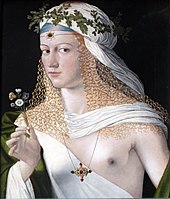Duchy of Ferrara
Duchy of Ferrara Ducatus Ferrariensis ( Emilian ) | |||||||||||
|---|---|---|---|---|---|---|---|---|---|---|---|
| 1471–1597 | |||||||||||
Alfonso II | |||||||||||
| History | |||||||||||
• Borso d'Este is elevated to Duke of Ferrara by Pope Paul II | 1471 | ||||||||||
| loses Ferrara to Papacy | 1597 | ||||||||||
| Currency | Ferrara mint, Idra, Ducat | ||||||||||
| |||||||||||
| Today part of | Italy | ||||||||||
The Duchy of Ferrara (
Background

The origin of Ferrara is uncertain. It was probably settled by the inhabitants of the lagoons at the mouth of the Po. There are two early centres of settlement: one around the cathedral,[3] the other, the castrum bizantino, being the San Pietro district, on the opposite shore, where the Primaro empties into the Volano channel. Ferrara appears first in a document of the Lombard king Desiderius of 753 AD,[4] as a city forming part of the Exarchate of Ravenna. Desiderius pledged a Lombard ducatus ferrariae ("Duchy of Ferrara") in 757 to Pope Stephen II.
The Marquis
The free municipality of Ferrara survived for about 150 years. From 1208, with
History

Composers came to Ferrara from many parts of Europe, especially France and Flanders. Josquin des Prez worked for Duke Ercole for a time (producing the Missa Hercules dux Ferrariæ, which he wrote for him). Jacob Obrecht came to Ferrara twice (and died during an outbreak of plague there in 1505). Antoine Brumel served as principal court musician from 1505. Alfonso I, son of Ercole, was also an important patron; his preference for instrumental music resulted in Ferrara becoming an important centre of composition for the lute.
The architecture of Ferrara benefitted from the genius of Biagio Rossetti, who was asked in 1484 by Ercole I to redesign the plan of the city. The resulting "Addizione Erculea" is one of the most important and beautiful examples of Renaissance city planning and contributed to the selection of Ferrara as a World Heritage Site by UNESCO.
Alfonso married the notorious Lucrezia Borgia, and continued the war with Venice with success. In 1509 he was excommunicated by Pope Julius II, and he overcame the pontifical army in 1512 defending Ravenna. (Gaston de Foix fell in this battle, as an ally of Alfonso.) Lucrezia, together with other members of the Este house, is buried in the convent of Corpus Domini.
Alfonso made peace with the succeeding popes. He was the patron of

His son
The city was much affected by the 1570 Ferrara earthquake.
When Alfonso died in 1597, he had no legitimate male heir. The Este lands were inherited by Alfonso's cousin Cesare d'Este. However, the succession was not acknowledged by Pope Clement VIII. Ferrara was claimed as a vacant fief by the Pope, as was Comacchio. The House of Este retained Modena and Reggio, which they held until 1796, apart from short interludes.
Dukes of Ferrara

- Borso 1471–1471 (Duke of Modena and Reggio from 1452, Duke of Ferrara from 1471)
- Ercole I1471–1505
- Alfonso I 1505–1534
- Ercole II 1534–1559
- Alfonso II 1559–1597
- 1597 – to the Papal States
See also
- House of Este
- Historical states of Italy
- Duchy of Modena and Reggio
References
- ^ Tuohy, Thomas. Herculean Ferrara: Ercole d'Este (1471–1505) and the Invention of a Ducal Capital. Cambridge: Cambridge University Press, with the assistance of the Istituto di Studi Rinascimentali, Ferrara.
- ^ Ducato di Ferrara (in Italian). p. 25.
- ^ The See was moved here from Vicohabentia (Voghenza) in 624 (Chronology of Catholic dioceses: Italy).
- ^ [1] Archived December 1, 2010, at the Wayback Machine
- ^ Rossi, Bruno (1972). Gli Estensi (in Italian). Mondadori. p. 6.
- ^ Maria Ricci, Franco (1999). Ducato di Ferrara (in Italian). AA. VV. p. 25.
- ^ "BORSO d'Este, duca di Modena, Reggio e Ferrara in "Dizionario Biografico"". www.treccani.it (in Italian). Retrieved 2021-07-05.
- The Walters Art Museum.
Sources
- Trevor Dean, Land and Power in Late Medieval Ferrara: The Rule of the Este, 1350–1450.(Cambridge University Press) 1987.
- Cecily Booth, Cosimo I - Duke Of Florence, 1921, University Press
External links
- Il Castello Estense: genealogical tree
- Dosso Dossi: Court Painter in Renaissance Ferrara, a full text exhibition catalog from the Metropolitan Museum of Art.


